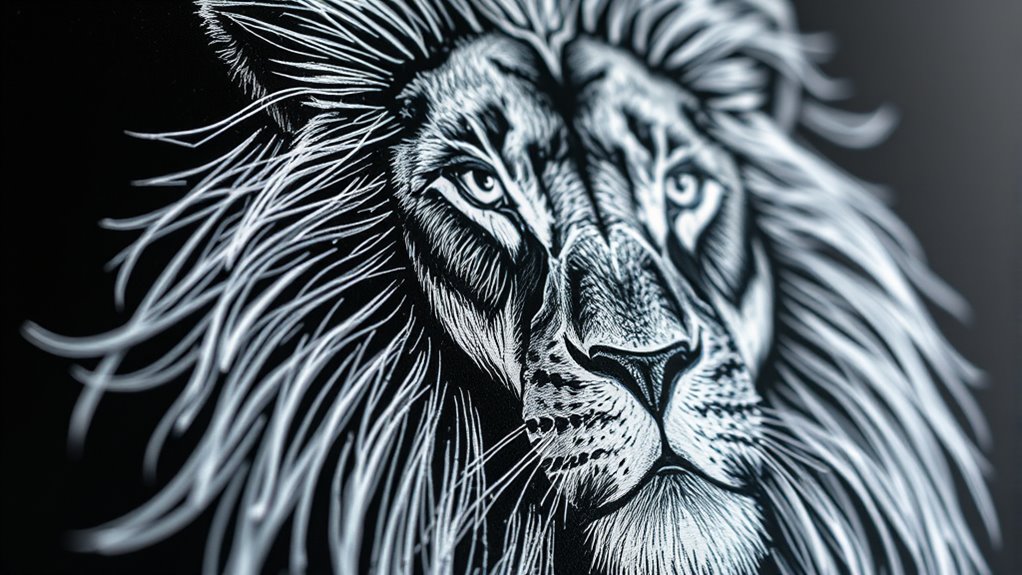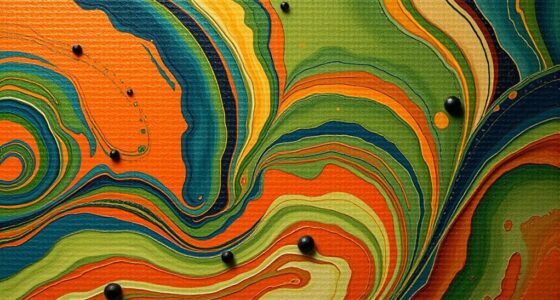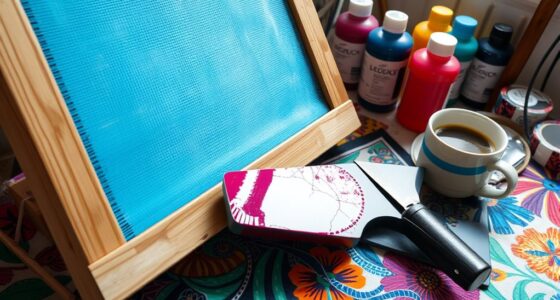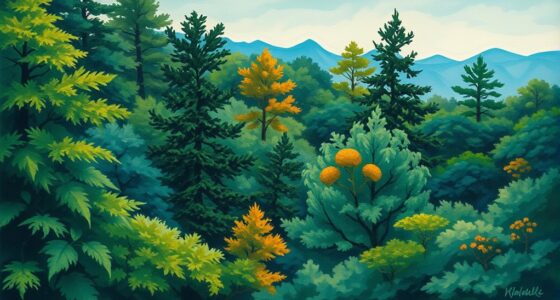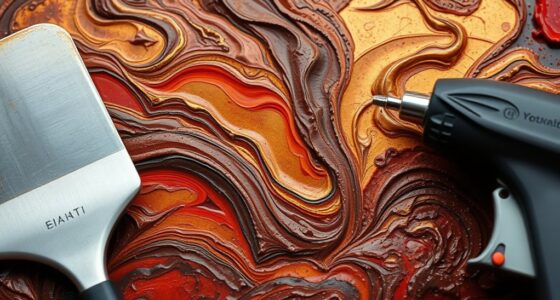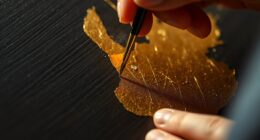Scratchboard art is a detailed technique where you use sharp tools to carve away a black surface, revealing the white layer underneath to create striking images. With careful control, you can produce realistic portraits, wildlife, or intricate designs full of texture and depth. The process requires patience and precision but offers dramatic shading and fine details. If you want to explore how artists master this unique art form, there’s much more to discover beyond the surface.
Key Takeaways
- Scratchboard art involves scratching away a black surface to reveal a white layer beneath, creating detailed images with depth.
- Artists use specialized tools like knives and needles to carefully carve intricate designs and shading.
- The technique has historical roots in traditional engraving methods, evolving with modern tools and digital influences.
- Planning and patience are essential, as artists meticulously scratch to achieve realistic textures and fine details.
- Contemporary applications include gallery exhibitions, illustrations, and commercial artwork, showcasing its tactile and visual impact.

Have you ever wondered how artists create such striking, highly detailed images with just a few simple tools? Scratchboard art is a fascinating example of this skill, where artists use a specialized board coated with a layer of white clay beneath a black ink surface. By scratching away the top layer, they reveal the white beneath, creating intricate images full of depth and texture. This technique has a rich history, rooted in traditional methods that date back centuries. Historically, artists used scratch techniques to create detailed illustrations and engravings, especially before the advent of modern printing. These early techniques relied on fine tools like needles, knives, and burins to carve into the surface, allowing for precise lines and shading. Over time, the methods evolved, blending traditional craftsmanship with new materials and tools, leading to the development of modern applications. Today, scratchboard art is not just a craft but a recognized art form, used by illustrators, fine artists, and commercial designers alike. Modern techniques incorporate specialized scratch tools—ranging from fine-pointed knives to electric scratchers—that provide greater control and detail. Artists now also use colored inks or layered techniques to add vibrancy and depth, expanding the creative possibilities. The advent of digital technology has further influenced scratchboard artistry, with some artists experimenting with digital tools to simulate scratching effects, blending traditional aesthetics with contemporary innovation. Despite these advancements, the core of scratchboard art remains rooted in its history techniques—careful, deliberate scratching that demands patience and precision. The process involves planning the image carefully, often sketching out a composition before scratching begins, ensuring the final piece captures the desired details. The contrast between the black surface and the white reveal allows for dramatic shading and fine details, making it ideal for realistic portraits, wildlife, and highly detailed illustrations. In modern applications, scratchboard art is showcased in galleries, used in book illustrations, and even incorporated into commercial advertising. Its tactile quality and striking visual impact make it a versatile medium that continues to inspire artists worldwide. Whether you’re just starting or are a seasoned creator, understanding the blend of history techniques and modern tools behind scratchboard art can deepen your appreciation for this unique craft. It’s a perfect example of how traditional methods can evolve and thrive in contemporary settings, offering endless possibilities for artistic expression. As you explore scratchboard art, remember that the essence lies in the careful removal of material to reveal what’s beneath, creating images that are as intricate as they are mesmerizing.
Frequently Asked Questions
What Tools Are Best for Scratchboard Art?
You should use sharp tools like X-Acto knives, needle tools, or scratch tools to achieve detailed etching techniques. Fine-tipped tools help you create precise lines, while broader tools can add texture. For color integration, consider using colored inks or pastels alongside your scratchboard. These tools allow you to effectively reveal images through scratching, combining etching techniques and color highlights to make your artwork stand out.
How Long Does It Typically Take to Complete a Piece?
The time estimation for your scratchboard art hinges on complexity and detail, like steering a winding river through a foggy morning. You might spend a few hours on a simple piece, or several days on a highly detailed masterpiece. The artistic process is a journey of patience and precision, where each scratch is a step closer to revealing your vision. Expect your project to take anywhere from hours to weeks, depending on your ambition.
Can Scratchboard Art Be Reproduced or Printed?
Yes, you can reproduce or print scratchboard art using digital reproduction and archival printing techniques. You simply scan or photograph your artwork at high resolution, ensuring details are captured accurately. Then, with archival inks and paper, you can create high-quality prints that preserve your original’s detail and texture. This allows you to share, sell, or display your work without risking damage to the original piece.
What Are Common Mistakes Beginners Make?
You might find that beginners often overlook the importance of color contrast and proper scratching techniques, which can lead to less striking images. Be mindful not to press too hard or too softly, as this affects detail and depth. Instead, practice gentle, controlled scratching to build contrast gradually. Remember, patience and attention to detail are key, helping you avoid common pitfalls and create more compelling, visually dynamic scratchboard art.
How Do I Protect and Preserve Finished Artwork?
To protect and preserve your scratchboard art, you should use preservation techniques like applying a fixative spray to prevent smudging and dust accumulation. Framing considerations are also essential; choose UV-protective glass and acid-free mats to prevent discoloration and deterioration over time. Handle your artwork with clean hands or gloves, and store it in a cool, dry place when not on display to guarantee longevity and vibrant appearance.
Conclusion
Now that you’ve uncovered the secrets of scratchboard art, you’re armed with the power to transform blank surfaces into stunning masterpieces. With just a scratch, you can release a storm of intricate details and breathtaking images that can rival the most famous artworks in history. So go ahead, scratch away like a fearless artist on a mission—because no other art form lets you reveal hidden worlds with such explosive precision and jaw-dropping beauty!
